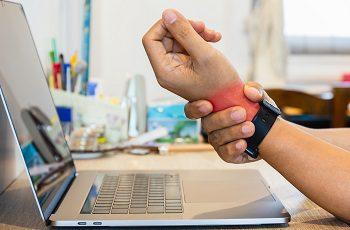Tech-Savvy and Hand-Healthy: Minimizing Carpal Tunnel Risk in the Digital Age
- posted: Aug. 14, 2023
In today’s fast-paced digital world, we rely heavily on technology for everyday tasks. From typing on keyboards to using touchscreens, our hands play a crucial role in navigating this tech-savvy lifestyle. However, increased reliance comes with a potential health risk, i.e., carpal tunnel syndrome.
Inside your wrist, there’s a narrow passageway called the carpal tunnel. This tunnel contains tendons and a nerve called the median nerve. Excessive pressure on the median nerve can lead to sensations of numbness, tingling, pain, and weakness in your hand and fingers.
This pressure often happens due to repetitive hand movements, like typing on a computer or using tools, or from conditions like arthritis or fluid retention. While traditional jobs like typing were once considered the primary culprits, the widespread use of smartphones, tablets, and other digital devices has expanded the at-risk population.
The implications of carpal tunnel syndrome are not to be underestimated. Beyond the discomfort and inconvenience, it can significantly impact productivity and overall well-being. Luckily, we can take proactive steps to reduce the risk and keep our hands healthy while staying digitally connected.
From simple exercises to promote hand flexibility and strength to setting up an ergonomic workstation, we will provide you with invaluable insights on safeguarding your hands from the strains of the digital world. Remember, being tech-savvy doesn’t have to come at the expense of your hand health.
By arming yourself with knowledge and adopting mindful practices, you can confidently navigate the digital age and protect your most essential tools, i.e., your hands. Let’s learn proactive measures to ensure your hands stay healthy and capable amidst the ever-evolving tech landscape.
“It is estimated that CTS affects approximately 3-6% of the general population, making it one of the most common nerve disorders worldwide”.
Understanding Carpal Tunnel Syndrome: Causes and Symptoms
Carpal tunnel syndrome (CTS) is a widespread condition that impacts millions of individuals globally, particularly in today’s digital age. Understanding the causes and symptoms of CTS is essential to address and minimize its impact on hand health effectively.
Causes of Carpal Tunnel Syndrome:
Various factors can lead to the development of carpal tunnel syndrome, including:

- Repetitive Hand Movements: Engaging in repetitive hand and wrist motions, such as typing, texting, or using a mouse for extended periods, can strain the tendons and tissues within the carpal tunnel, leading to inflammation, swelling, and compression of the median nerve.
- Wrist Position: Performing tasks with an awkward or bent wrist position can increase pressure on the median nerve and lead to CTS.
- Hand and Wrist Anatomy: Some individuals may have a narrower carpal tunnel or a genetic predisposition to CTS, making them more susceptible.
- Medical Conditions: Certain medical conditions, for instance, diabetes, rheumatoid arthritis, and hypothyroidism, can increase the risk of carpal tunnel syndrome.
- Pregnancy: During pregnancy, hormonal changes can result in fluid retention, which increases pressure within the carpal tunnel and may lead to symptoms of carpal tunnel syndrome (CTS).
Symptoms of Carpal Tunnel Syndrome:
CTS can present a range of symptoms, varying in severity, and may initially appear mild but progress over time. The common signs and symptoms include the following:
- Numbness and Tingling: People with CTS commonly feel tingling in their thumb, index, middle, and ring fingers. This sensation is usually more pronounced during nighttime or after repetitive hand use.
- Hand Weakness: Weakening grip strength and difficulty holding objects are common indicators of carpal tunnel syndrome as the condition progresses.
- Pain and Discomfort: CTS sufferers may experience pain or aching in the hand, wrist, and forearm. The discomfort may radiate up the arm or into the shoulder.
- Clumsiness: Reduced hand coordination and a tendency to drop objects can occur due to impaired nerve function.
- Nighttime Awakenings: Many individuals with CTS find that their symptoms worsen at night, leading to disrupted sleep patterns.
If you experience any of these symptoms or suspect you might have carpal tunnel syndrome, it is crucial to seek medical attention promptly. Early intervention can help obstruct the condition from worsening and improve the chances of successful treatment.
How to Minimize Carpal Tunnel Risk in the Current Times?
Lessening the risk of carpal tunnel syndrome (CTS) involves adopting a proactive approach that focuses on ergonomic practices, lifestyle adjustments, and self-care. Here are practical tips and ergonomic strategies to help reduce the risk of developing CTS:

- Maintain Proper Wrist Positioning: Ensure your wrists are neutral when using digital devices or performing repetitive tasks. Avoid excessive bending or flexing of the wrists to reduce pressure on the median nerve.
- Ergonomic Workstation Setup: Adjust your computer workstation to promote good posture and hand alignment. You should ensure that your keyboard and mouse are positioned at the correct height and angle to avoid excessive wrist extension or flexion.
- Take Frequent Breaks: Incorporate regular breaks into your work or gaming routine to give your hands and wrists time to rest and recover. Use these breaks to perform gentle hand stretches and exercises.
- Practice Good Typing Techniques: If you spend extended hours typing, adopt proper typing techniques to reduce strain on your hands and fingers. Keep your wrists straight, and avoid resting them on hard surfaces while typing.
- Use Ergonomic Tools: Invest in an ergonomic keyboard, mouse, and wrist support to reduce wrist strain and promote a more natural hand position.
- Alternate Hands: Switch between hands when performing repetitive tasks, such as mouse usage or holding your phone, to distribute the workload and reduce strain on a specific hand.
- Stretch and Exercise: You should include hand, and wrist stretches in your daily routine to enhance flexibility and circulation. You can try simple exercises such as wrist circles, finger movements, and hand squeezes, which can be highly beneficial.
- Improve Overall Fitness: Maintaining good physical fitness can improve hand health. Regular exercise, primarily focusing on strength and flexibility, can help reduce the risk of CTS.
- Manage Underlying Health Conditions: If you have conditions such as diabetes, rheumatoid arthritis, or hypothyroidism, it’s pivotal to work closely with your healthcare provider to effectively manage your symptoms and pain, as they can heighten the risk of CTS.
- Use Voice Recognition Technology: Consider using voice recognition software for tasks that involve extensive typing to give your hands a break and reduce the strain on your wrists.
- Practice Mindful Device Use: Be mindful of the time spent using digital devices and take conscious breaks to rest your hands. Avoid holding your phone or tablet in awkward positions for extended periods.
- Warm Up Before Intense Hand Use: Before engaging in repetitive hand movements, such as gaming, warm up your hands with gentle stretches to prepare them for the task ahead.
Integrating these practical tips and ergonomic strategies into your daily routine can effectively decrease the risk of carpal tunnel syndrome in this modern lifestyle and enhance overall hand health in the digital age. Remember that early recognition of symptoms and seeking prompt medical advice can help manage CTS effectively and prevent its progression.
Concluding Thoughts
Safeguarding hand health is crucial to minimize the risk of carpal tunnel syndrome (CTS) in the tech-driven world. Adopt ergonomic practices, maintain proper wrist positioning, and use specialized tools to reduce strain. Take regular breaks, do hand exercises, and be mindful of tech usage to promote flexibility and strength.
Address underlying health conditions and consider a multi-modal approach for effective CTS management. Embrace awareness, education, and proactive self-care to navigate the digital age with healthy hands.
Contact your Scottsdale Chiropractor, Dr. Abbas Khayami, D.C, at Better Health Solutions to learn about Minimizing Carpal Tunnel Risk in the Digital Age.
Resource:
Alleviate Accident-Related Discomfort with Chiropractic Therapy
*This media/content or any other on this website does not prescribe, recommend, or prevent any treatment or procedure. Therefore, we highly recommend that you get the advice of a qualified dentist or other medical practitioner regarding your specific dental condition*
Better Health Solutions
8040 E Indian School Rd Suite 100,
Scottsdale, AZ 85251
Monday
8:30 am - 6:00 pm
Tuesday
8:30 am - 6:00 pm
Wednesday
8:30 am - 6:00 pm
Thursday
8:30 am - 6:00 pm
Friday
8:30 am - 6:00 pm
Saturday
8:30 am - 2:30 pm
Sunday
Closed
